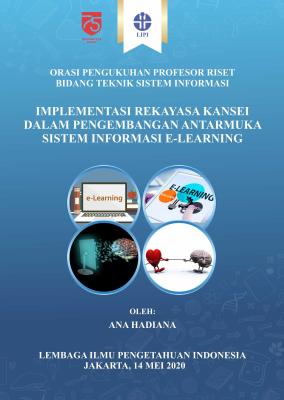Implementasi Rekayasa Kansei dalam Pengembangan Antarmuka Sistem Informasi E-Learning
Keywords:
Rekayasa Kansei, E-Learning, AntarmukaSynopsis
Rekayasa Kansei yang pertama kali diusulkan oleh Mitsuo Nagamachi, seorang profesor dari Hiroshima University, merupakan suatu pendekatan untuk mengidentifikasi kebutuhan emosional pengguna yang kemudian dikonversi menjadi struktur tampilan antarmuka yang selaras dan sesuai dengan keinginan pengguna. Penerapan Rekayasa Kansei perlu dilakukan untuk menganalisis secara akurat faktor emosional pengguna terkait dengan perangkat lunak e-Learning, khususnya antarmuka karena bagian ini merupakan bagian terpenting yang berperan dalam menghubungkan pengguna dengan sistem internal sistem informasi e-Learning. Tampilan antarmuka sangat menentukan kenyamanan perangkat lunak bagi pengguna serta menentukan pengalaman pengguna terhadap sistem informasi e-Learning. Selanjutnya, orasi ini akan membahas tentang perkembangan perangkat lunak sistem informasi e-Learning berorientasi pengguna (Bab II), peran penting Rekayasa Kansei dalam menganalisis dan merancang perangkat lunak sistem informasi e-Learning (Bab III), bagaimana kontribusi Rekayasa Kansei dalam pengembangan perangkat lunak sistem informasi e-Learning (Bab IV), dan strategi penerapan Rekayasa Kansei pada pengembangan perangkat lunak (Bab V).
Downloads
References
Laudon KC, Jane PL. Management information systems: managing the digital firm, 15th Edition. ISBN: 978-0-13-214285-4. New
Jersey: Prentice Hall; 2012.
Hadiana A. Perencanaan arsitektur enterprise perguruan tinggi menggunakan oracle framework. Jurnal Teknologi dan Manajemen Informatika 2016; 1(1).
Hadiana A. Perencanaan & pengembangan sistem informasi terpadu. ISBN: 978-602-70535-5-7. Bandung: Megatama; 2016.
Hadiana A. Framework enterprise resource planning. ISBN: 978-602-52891-2-5. Bandung: Megatama; 2018.
Elkins D, Pinder D. E-Learning fundamentals: a practical guide. ISBN: 978-1562869472. Virginia: Association for Talent Development; 2015.
Brambilla M, Cabot J, Wimmer M. Model-driven software engineering in practice 2nd Edition, Morgan & Claypool Publishers;
Hadiana A. Rekayasa Kansei dalam perancangan web. ISBN: 978-602-70535-5-7. Bandung: Megatama; 2016.
Shneiderman B, Plaisant C, Cohen M, Jacobs S. Designing the user interface: strategies for effective human computer interface
th Edition. New York: Addison-Wesley; 2016.
Nagamachi M, Lokman AM. Kansei Innovation: Practical design applications for product and service development. Boca Raton:
CRC Press; 2015.
Savendy G. Handbook of human factors and ergonomics 4th edition. New Jersey: John Willey & Sons Inc.; 2012.
Nagamachi M, Lokman AM. Innovations of Kansei engineering. Boca Raton: CRC Press; 2011.
Ampornaramveth V, Zang T, Hadiana A, Ueno H. A Web-based e-learning platform for post-graduate education. Proceeding of
th IASTED International Conference on Web-based Education; 2006. 388–393.
Hadiana A, Zhang T, Ampornaramveth V, Ueno H. Web E-learning system based on concept of online whiteboard. Proceeding
of 2nd International Conference on Web Information System and Technologies (WEBIST); 2006. 387–391.
Redzuan F, Lokman AM, Othman ZA, Abdullah S. Kansei Design model for e-learning: a preliminary finding. Proceeding of the 10th European Conference on e-Learning (ECEL); 2011. 685–696.
Hadiana A, Kaijiri K. Q&A learning support system using peer help. Journal of Japan System Information for System Education
(JSISE). 2004; 20(4)
Hadiana A. Aplikasi e-learning dengan open source webels. Jurnal Media Informatika. 2009; 8(1). 17. Hadiana A, Djaelani E. Student centered collaborative learning using Q&A on web. Jurnal Teknologi Informasi. 2003; 4(1).
Hadiana A, Kaijiri K. The investigation of Q&A learning support system using peer help. Proceeding of Forum on Information
Technology (FIT); 2003. 389–390.
Hadiana A, Kaijiri K. The construction of asynchronous Q&A support system based on collaboration. Proceeding of Forum on
Information Technology (FIT); 2002. 273–274.
Hadiana A, Kaijiri K. The construction of the asynchronous distance learning support system: ActiveWeb. The Institute of Information Processing Research Report 2002. 58–64.
Hadiana A. Rekayasa sistem informasi. ISBN: 978-979-99701-9-4. Bandung: Megatama; 2016.
Lokman AM. Design & emotion: the Kansei engineering methodology. The Malaysian Journal of Computing. 2010; 1(1).
Norman DA. Emotional Design: why we love (or hate) everyday things. Basic Books; 2004.
Chuan NK, Sivaji A, Shahimin MM, Saad N. Kansei Engineering for e-commerce sunglasses selection in Malaysia. Proceeding
of The 9th International Conference on Cognitive Science; 2013. 707–714.
Chen M, Hsu C, Chang K, Chou M. Applying Kansei Engineering to design logistics services – a case of home delivery service.
International Journal of Industrial Ergonomics. 2015; 48(6).
Hadiana A. Analysis learners’ preference in e-learning system using Kansei approach. Dalam: Book of trends in E-learning.
London: IntechOpen; 2018. DOI: 10.5772/intechopen.71183. 105–119.
Hadiana A, Abdurrohman. Analysis of customers’ emotional preferences using Kansei engineering and AHP. Proceeding of
th International Conference on Science and Technology (ICST); 2018. 102–105.
Hadiana A, Dahlan R, Wardoyo R, Syamsi D. Kansei Analysis for transmedia storytelling products based on story and character.
Proceeding of International Seminar on Applicatoin for Technology of Information and Communication (iSemantic); 2018. 85–89.
Ginting S, Hadiana A. Interface and service analysis on student website using Kansei engineering and kano. Proceeding of 1st International Conference on Informatics, Engineering, Sciences and Technology (INCITEST); 2018. 1–6.
Hadiana A, Dauni P, Lokman AM. Kansei engineering implementation in designing user interface for web based academic
information system. International Journal of Basic and Applied Science. 2016; 4(3): 42–50.
Hadiana A. Kansei based interface design analysis of open source e-learning system for high education. Proceeding of International Conference on Computer, Control, Informatics and Its Applications (IC3INA); 2016. 89–92.
Hadiana A. Interface modeling for mobile learning using kansei engineering and analytical hierarchy process. Proceeding of International Conference on Computer, Control, Informatics and Its Applications (IC3INA); 2017. 151–155.
Hadiana A, Lokman AM. Kansei Evaluation in open source e-learning system. Jurnal Teknologi. 2016; 78(12): 135–139.
Hadiana A. Kansei analysis of interface’s elements for mobile commerce application. Proceeding of 4th International Conference
on Information and Communication Technology (ICoICT); 2016. 122–126.
Rahadyan, D, Hadiana A. Pengembangan sistem pendukung keputusan menggunakan Kansei engineering dan analytical hierarchy process. Jurnal Tata Kelola dan Kerangka Kerja Teknologi Informasi (JTK3TI). 2018; 4(1): 15–24.
Hadiana A. Web based e-learning system analysis using Kansei engineering. Proceeding of 3rd International Conference on
Information and Communication Technology (ICoICT); 2015. 558–562.
Matahari, Hadiana A. Alumni absorption assessment for tracking alumni interest using analytical hierarchy process and technique for order preference by similarity to ideal solution. Proceeding of 1st International Conference on Informatics, Engineering, Sciences and Technology (INCITEST); 2018. 1–7.
Hadiana A. Designing interface of mobile parental information system based on users’ perception using Kansei engineering.
Journal of Data Science and Its Applications. 2018; 1(1). 1–10.
Hadiana A. Study of application interface based on user’s perception using Kansei approach. Proceeding of International Conference on Computer, Control, Informatics and Its Applications (IC3INA); 2018. 124–128.
Lokman AM, Ishak KK, Hadiana A. Premo and Kansei: a comparative analysis. International Journal of Basic and Applied Science. 2013; 1(4): 734–744.

Downloads
Published
Categories
License

This work is licensed under a Creative Commons Attribution-NonCommercial-ShareAlike 4.0 International License.






























